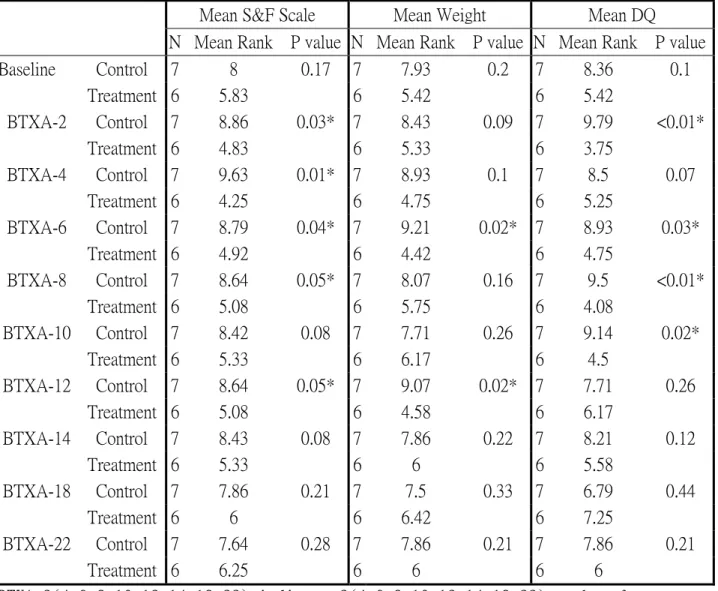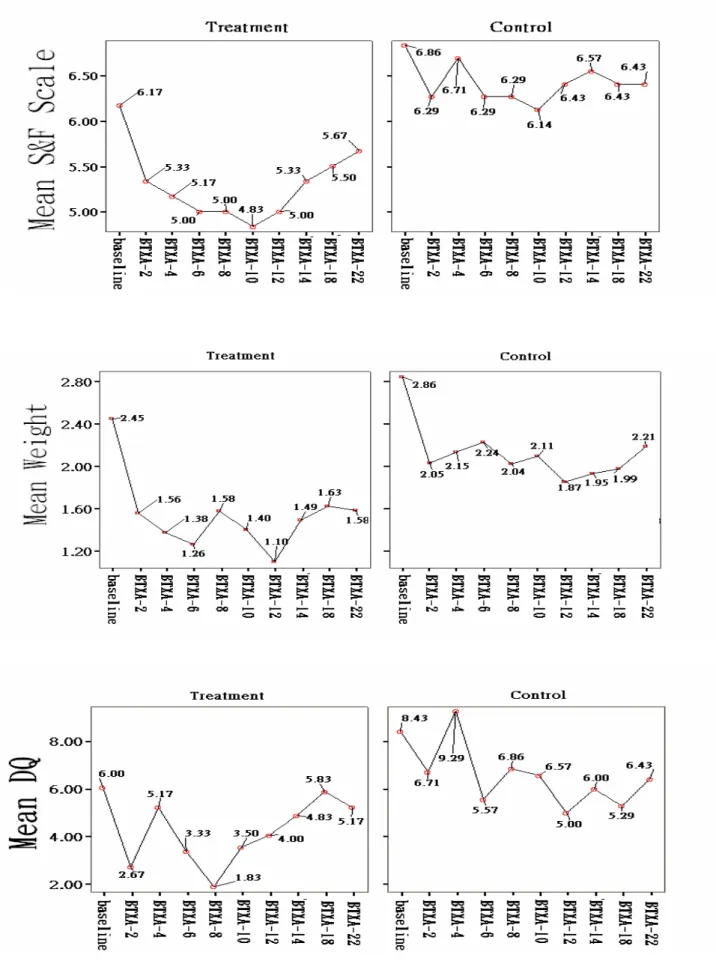行政院國家科學委員會專題研究計畫成果報告
以
A 型肉毒桿菌毒素治療腦性麻痺患者的流涎問題
Application of botulinum toxin type A to treat drooling in cerebral
palsy
計畫編號:NSC 93-2614-B-002-005
執行期限:93 年 8 月 1 日至 94 年 7 月 31 日
主持人:謝正宜 國立台灣大學醫學院復健科
一、中文摘要 腦性麻痺合併有流涎問題的比例約 10-37%,肉毒桿菌毒素抑制神經末稍乙醯 膽鹼分泌的機轉應可減少唾液之分泌。本 研究的目的是評估利用 A 型肉毒桿菌毒 素局部注射於唾液腺的方法來治療腦性 麻痺患者流涎的可行性,並確認此注射劑 量是否適當及了解藥效維持的時間和可 能的副作用。病患隨機分成治療組與對照 組,其中治療組接受肉毒桿菌毒素注射入 單側之頷下腺及耳下腺腺體中,每公斤體 重使用 2 U (Botox);對照組接受生理食 鹽水注射入單側之頷下腺及耳下腺腺體 中。病患在注射前一週與注射後特定時間 點分別測量流涎嚴重度與頻率、流涎量、 流涎商數三種指標,並比較治療組與對照 組、治療組注射肉毒桿菌毒素前後三種指 標的差異。結果顯示,術後三個月內治療 組 比 對 照 組 病 患 的 流 涎 獲 得 顯 著 的 改 善,且治療組的病患顯著的比未注射肉毒 桿菌毒素前有明顯的改善,治療及追蹤期 間並未發現嚴重的副作用。由本研究的結 果,我們認為肉毒桿菌毒素注射治療腦性 麻痺患者流涎是個有效且副作用少的方 式。 關鍵詞:腦性麻痺、流涎、肉毒桿菌毒 素 AbstractAbout 10-37% patients with cerebral palsy have the problem of drooling.
Botulinum toxin might be able to lower the amount of saliva through its mechanism in
inhibiting the acetylcholine release from neuroglandular junction. The aim of this study is to evaluate the effect, side-effects and safety of botulinum toxin injection in treating drooling in cerebral palsy. We conducted a randomized double-blinded placebo-controlled trial with botulinum toxin and normal saline injected to major salivary glands in experimental and control group respectively. Outcome measures including drooling severity and frequency scale, the amount of saliva production, and the drooling quotient were used for
evaluation before injection and at regular intervals after injection. The results showed that drooling improved significantly in experimental group within 12 weeks after injection. In patients receiving botulinum toxin injection, all outcome measures differed significantly before and during the 14 weeks after injection. There is no side effect during the 22 weeks follow-up periods. In the study of application of botulinum toxin type A to treat drooling in cerebral palsy, we found botulinum toxin injection is effective and safe.
Keywords: cerebral palsy、drooling、 botulinum toxin 二、緣由與目的 腦性麻痺是因為未成熟的中樞神經系 統,受到非進行性的傷害,日後導致動作、 姿態或其他方面的異常。它是造成兒童殘 障最常見的疾病之一。腦性麻痺患者中, 合併有流涎問題的比例有 10-37%[1]。過 度流涎會造成局部皮膚及衣物的潮溼,導
2 致病人的不舒服及不衛生,增加照顧者的 負擔,影響患者說話能力,甚至引起吸入 性肺炎或身體脫水等問題。雖然有許多治 療方法曾被提出且應用過,例如各種不同 的物理治療及吞嚥治療,降低唾液分泌的 口服藥物,破壞唾液腺或其支配神經的手 術方法等[2-4];但到目前為止,沒有任何 一項治療方法可以算是完全成功,且許多 方法存在著不小的副作用。 副交感神經的節後神經分泌神經傳導 物質乙醯膽鹼來刺激唾腺分泌唾液,肉毒 桿菌毒素抑制神經末稍乙醯膽鹼分泌的機 轉應可減少唾液之分泌。所以局部唾液腺 體內注射肉毒桿菌毒素以降低流涎成為近 年來研究的新方向[5-7]。對於以局部唾液 腺內注射肉毒桿菌毒素以降低流涎的治療 方法而言,雖然初步效果不錯,但目前只 有幾篇零星的報告,實驗的個案數目也很 少,且大部份治療的對象是成人神經系統 疾病患者 (如巴金森氏症或側索硬化肌萎 縮症),而非專注於治療腦性麻痺兒童的流 涎[8-13]。由肉毒桿菌毒素應用於治療腦 性麻痺兒童痙攣張力的臨床經驗,局部唾 液腺體內注射肉毒桿菌毒素應可減少唾液 之分泌,而唾液分泌之減少應可降低腦性 麻痺兒童流涎的程度及頻率。 本研究的主要目的,是評估利用 A 型肉毒桿菌毒素局部注射於唾液腺的方 法來治療腦性麻痺患者流涎的可行性,並 確認此注射劑量是否適當及了解藥效維 持的時間和可能的副作用。 三、研究方法 本研究一共收集腦性麻痺患者 13 名,每一位患者均須符合下列條件:1.年 齡介於四歲到二十一歲。2.流涎構成照顧 者或患者本身困擾者。3.無出血體質或其 他健康問題而不能接受肉毒桿菌毒素注 射。4.無對肉毒桿菌毒素或其藥劑的其他 成分過敏的病史。5.最近 6 個月內未因其 他適應症接受過肉毒桿菌毒素注射。6.未 使用抗乙醯膽鹼藥物、抗癲癇藥物、或安 眠藥等會影響唾液分泌的藥物。7.未經手 術或放射線治療以改善流涎。8.目前未接 受語言治療師針對流涎問題處理的訓練計 畫。研究設計採用雙盲與隨機方式進行。 病患進入本研究後我們採取隨機分派的方 式將其隨機分成治療組與對照組,其中治 療組接受肉毒桿菌毒素注射入單側之頷下 腺及耳下腺腺體中,每公斤體重使用 2 U。 對照組接受生理食鹽水注射入單側之頷下 腺及耳下腺腺體中。 在注射前先行進行臨床評估。內容包 括 1.先進行尿液試驗排除懷孕者。2.身 高、體重。3.定性流涎程度評估:利用流 涎嚴重度量表及流涎頻率量表[14]。其中 流涎嚴重度量表包含:A.乾淨(dry):病人 不會流涎。B.輕微(mild):只有嘴唇潮溼。 C.中度(moderate):嘴唇與下巴潮溼。D. 嚴重(severe):衣服潮溼。E.大量 (profuse):衣服、雙手及其他物品皆潮 溼。流涎頻率量表包含 A.從未流涎 (never)。B.偶而流涎(occasional, not every day)。C.經常流涎(frequent, every day)。D.隨時流涎(constant)。4.定量流 涎程度評估:利用紗布棉卷讓腦性麻痺患 者含在口中 2 分鐘後取出,以電子磅秤測 其流涎重量。流涎商數(Drooling Quotient):每 15 秒觀察一次口水流到唇 邊的情形後擦乾,記錄 10 分鐘內口水流到 唇邊的總次數。並於術後 2、4、6、8、10、 12、14、18、22 週也進行相同的測量。 四、結果與討論 本研究一共收取了13個患者,其中包 含6位男性與7位女性。患者年齡分布為8 至21歲,平均年齡為14.2±1.8歲。本研究共 包含兩個部分:第一個部份是將13位患者 隨機分為治療組(注射肉毒桿菌毒素)與對 照組(注射生理食鹽水),並比較兩組的差 別。其中治療組包含4個男性與2個女性, 平均年齡為15.7±4.7歲;對照組包含4個男 性與3個女性,平均年齡為12.7±4.2歲,兩 組間在性別與年齡上皆無顯著差異。並且 在我們所測量的三個指標包括:流涎嚴重 度及頻率量表(Mean S&F Scale)、流涎量 (Mean Weight)、流涎商數(Mean DQ)都沒有 顯著性的差異,也初步排除了兩組之間之 所以會有差異是因為一開始兩組病人的嚴 重程度有不同所造成的結果。第二部份是 分別於病人在注射肉毒桿菌毒素前一週與 注射後二週、四週、六週、八週、十週、 十二週、十四週、十八週、二十二週分別 測量流涎嚴重度及頻率量表(Mean S&F
Scale)、流涎量(Mean Weight)、流涎商數 (Mean DQ)等三種指標,並比較注射肉毒桿 菌毒素前後三種指標的差異。
在治療組與對照組的比較部份,因為 限於個案數太少因此在統計方法的選擇上 是利用Wilcoxon rank sum test,α level 訂 為 0.05 進行單尾檢定。本研究發現在利 用肉毒桿菌毒素治療後二週、四週、六週、 八週、十週、十二週,治療組的病人在流 涎嚴重度及頻率量表(Mean S&F Scale)與 流涎商數(Mean DQ)上都顯著的比對照組 來的輕微。換句話說,在術後三個月內治 療組病人的病情會獲得顯著的改善。但是 在流涎量(Mean Weight)這項指標上卻沒有 看到相同的結果(Table 1)。 在治療組的病人注射肉毒桿菌毒素前 後三種指標的比較部份,我們發現在注射 肉毒桿菌毒素之後不論是在流涎嚴重度及 頻率量表(Mean S&F Scale )、流涎量(Mean Weight )或是流涎商數(Mean DQ )都可以 發現病人的情況有很大的改善(Fig 1)。在 統計方法的選擇上是利用Wilcoxon signed ranks test,α level 訂為 0.05 進行單尾 檢定。結果發現接受肉毒桿菌毒素治療後 二週、六週、八週、十週、十二週、十四 週,病人在流涎嚴重度及頻率量表(Mean
S&F Scale )、流涎量(Mean Weight )、以及 流涎商數(Mean DQ )上都顯著的比未注射 肉毒桿菌毒素前有明顯的改善(Table 2), 除了在四週時可能因新醫師的評估標準與 原標準不同而致在流涎嚴重度及頻率量表 (Mean S&F Scale )與流涎商數(Mean DQ )二 項主觀的測量未有顯著差異。其中在流涎 量(Mean Weight)這項指標上甚至於在注射 22 週後仍然可以看到明顯的改善效果,可 能是因為此項測量是利用棉卷完整的收集 病人流涎量所以敏感度較高,因此在其他 兩項指標看不到差異時此項指標仍可達顯 著差異。至於為什麼在治療組與對照組的 比較,大部份卻沒有看到流涎量(Mean Weight)這項指標有顯著差異,可能是在兩 組比較時因為沒有考慮到個體之間的差 異,所以使得變異數增大,因而統計檢力 不足以發現兩組間些微的差異才會造成如 此的結果。我們以α=0.05,自由度=12(共 13 個案納入本研究)計算出統計檢力 (power)為 69.50%,因此我們可以進一步 的假設流涎量(Mean Weight )這項指標在 治療組與對照組可能會有顯著差異存在, 只是因為本研究個案數太少致統計檢力不 足才會沒有看到顯著差異的結果,但這個 結果仍需要其他更大型的研究加以驗證。
4
TABLE 1. Mean Differences between Treatment and Control Measurements
Mean S&F Scale Mean Weight Mean DQ N Mean Rank P value N Mean Rank P value N Mean Rank P value Baseline Control 7 8 0.17 7 7.93 0.2 7 8.36 0.1 Treatment 6 5.83 6 5.42 6 5.42 BTXA-2 Control 7 8.86 0.03* 7 8.43 0.09 7 9.79 <0.01* Treatment 6 4.83 6 5.33 6 3.75 BTXA-4 Control 7 9.63 0.01* 7 8.93 0.1 7 8.5 0.07 Treatment 6 4.25 6 4.75 6 5.25 BTXA-6 Control 7 8.79 0.04* 7 9.21 0.02* 7 8.93 0.03* Treatment 6 4.92 6 4.42 6 4.75 BTXA-8 Control 7 8.64 0.05* 7 8.07 0.16 7 9.5 <0.01* Treatment 6 5.08 6 5.75 6 4.08 BTXA-10 Control 7 8.42 0.08 7 7.71 0.26 7 9.14 0.02* Treatment 6 5.33 6 6.17 6 4.5 BTXA-12 Control 7 8.64 0.05* 7 9.07 0.02* 7 7.71 0.26 Treatment 6 5.08 6 4.58 6 6.17 BTXA-14 Control 7 8.43 0.08 7 7.86 0.22 7 8.21 0.12 Treatment 6 5.33 6 6 6 5.58 BTXA-18 Control 7 7.86 0.21 7 7.5 0.33 7 6.79 0.44 Treatment 6 6 6 6.42 6 7.25 BTXA-22 Control 7 7.64 0.28 7 7.86 0.21 7 7.86 0.21 Treatment 6 6.25 6 6 6 6
BTXA-2(4.6.8.10.12.14.18.22) indicate 2(4.6.8.10.12.14.18.22) weeks after Botulinum Toxin injection
Fig1 流涎嚴重度及頻率量表(Mean S&F Scale )、流涎量(Mean Weight )、流涎商數(Mean DQ )三種 指標平均值隨著注射時間之分布圖
6 五、結論 本研究評估利用A 型肉毒桿菌毒素局 部注射於唾液腺的方法來治療腦性麻痺患 者流涎的可行性,並確認此注射劑量是否 適當及了解藥效維持的時間和可能的副作 用。結果顯示術後三個月內治療組比對照 組病患的流涎獲得顯著的改善,且治療組 的病患顯著的比未注射肉毒桿菌毒素前有 明顯的改善,治療及追蹤期間並未發現嚴 重的副作用。由本研究的結果,我們認為 肉毒桿菌毒素注射治療腦性麻痺患者流涎 是個有效且副作用少的方式。未來希望利 用A 型肉毒桿菌毒素局部注射於唾液腺的 方法來處理其他中樞神經系統疾病如中風 及巴金森氏症等病人的流涎問題。 參考文獻
1. Crysdale WS: Management options for the drooling patient. Ear Nose Throat J 1989; 68: 820-30.
2. Lewis DW, Fontana C, Mehallick LK, et al: Transdermal scopolamine for
reduction of drooling in
developmentally delayed children. Dev Med Child Neurol 1994; 36: 484-6. 3. Lew KM, Younis RT, Lazar RH: The
current management of sialorrhea. Ear Nose Throat J 1991; 70: 99-105. 4. Ekedahl C: Surgical treatment of
drooling. Acta Otolaryngol 1974; 77:215-20.
5. Shaari CM, Wu BL, Biller HF, et al: Botulinum toxin decreases salivation from canine submandibular glands. Otolaryngol Head Neck Surg 1998; 118: 452-7.
6. Ellies M, Laskawi R, Gotz W, et al: Immunohistochemical and
morphometric investigations of the influence of botulinum toxin on the submandibular gland of the rat. Eur Arch Otorhinolaryngol 1999; 256: TABLE 2. Mean Differences Between Baseline and Follow-up Measurements
Mean S&F Scale Mean Weight Mean DQ
N Difference±SD P value N Difference±SD P value N Difference±SD P value baseline/BTXA-2 6 -0.69±0.75 0.01* 6 -0.85±0.66 <0.01* 6 -2.46±2.66 <0.01* baseline/BTXA-4 6 -0.54±1.12 0.11 6 -0.88±0.97 0.02* 6 -0.77±3.01 0.87 baseline/BTXA-6 6 -0.85±0.99 0.01* 6 -0.88±1.25 0.02* 6 -2.77±2.17 <0.01* baseline/BTXA-8 6 -0.85±0.80 <0.01* 6 -0.85±0.87 0.01* 6 -2.77±2.59 <0.01* baseline/BTXA-10 6 -1.00±0.91 <0.01* 6 -0.89±0.80 <0.01* 6 -2.15±3.08 0.03 baseline/BTXA-12 6 -0.77±0.93 0.02* 6 -1.16±1.06 0.01* 6 -2.77±2.35 <0.01* baseline/BTXA-14 6 -0.54±0.88 0.05 6 -0.93±0.77 <0.01* 6 -1.85±2.34 0.02* baseline/BTXA-18 6 -0.54±0.97 0.07 6 -0.85±0.7 <0.01* 6 -1.77±3.49 0.1 baseline/BTXA-22 6 -0.46±0.88 0.08 6 -0.75±0.76 <0.01* 6 -1.46±2.88 0.12 BTXA-2(4.6.8.10.12.14.18.22)indicate 2(4.6.8.10.12.14.18.22) weeks after Botulinum Toxin injection
148-52.
7. Ellies M, Laskawi R, Tormahlen G, et al: The effect of local injection of botulinum toxin A on the parotid gland of the rat: an immunohistochemical and morphometric study. J Oral maxillofac Sur 2000; 58: 1251-6.
8. Bushara KO: Sialorrhea in amyotrophic lateral sclerosis: a hypothesis of a new treatment- botulinum toxin A injections of the parotid glands. Med Hypotheses 1997; 48: 337-9.
9. Giess R, Naumann M, Werner E, et al: Injections of botulinum toxin A into the salivary glands improve sialorrhea in amyotrophic lateral sclerosis. J Neurol Neurosurg Psychiatry 2000; 69:121-3. 10. Bhatia KP, Munchau A, Brown P:
Botulinum toxin is a useful treatment in excessive drooling in saliva. J Neurol Neurosurg Psychiatry 1999; 67: 697. 11. Porta M, Gamba M, Bertacchi G, et al:
Treatment of sialorrhea with ultrasound guided botulinum toxin type A injection in patients with neurological disorders. J Neurol Neurosurg Psychiatry 2001; 70: 538-40.
12. Jost WH: Treatment of drooling in Parkinson’s disease with botulinum toxin. Mov Disord 1999; 14: 1057. 13. Pal PK, Calne DB, Calne S, et al:
Botulinum toxin A as treatment for drooling saliva in PD. Neurology 2000;54: 244-7.
14. Thomas-Stonell N, Greenberg J: Three treatment approaches and clinical factors in the reduction of drooling. Dysphagia 1988; 3: 73-8.


